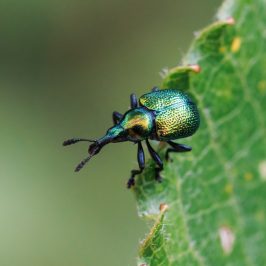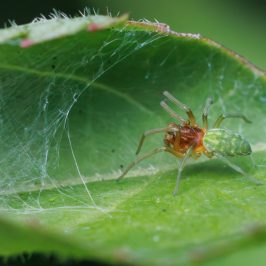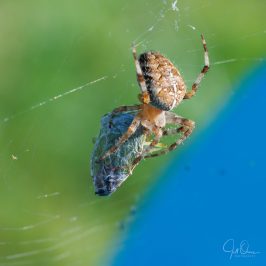It was so dark, damp, and chilly in the garden today that nothing was mad enough to sit around in the open exposing itself to the elements, and risk being consumed as fuel by something bigger, so I had to resort to beating a few inverts out of their shelters. I’ve rather lost the knack of this since last winter, so I didn’t do too well, but I’m currently so buried under overdue projects that I didn’t want to add to my workload anyway, so as soon as I’d found and photographed half a dozen nice specimens I gave up looking, and took myself back into the warm.
This final-instar Juniper Shieldbug nymph came out of our big Lawson cypress. This tree acts as a year-round hotel for a wide range of insects, and is the best place I know for finding the Juniper Shieldbug, a species that has massively increased in both numbers and range in the UK since giving up its previous reliance on juniper, and adopting the Lawson cypress as a secondary habitat. Having dislodged it onto my tray I quickly restored it to the cypress before any harm could befall it, and managed to grab a few shots before it moved into the depths of the tree. I was mildly disappointed that it wasn’t an early-instar nymph, because I want to know if they really do look this much like clowns, but I suspect that to find one of those I’d need to be searching much earlier in the season than this, and invertebrates are so plentiful in June and July that it never occurs to me then to go sweeping or beating.
This image may look dark, but it’s very much lighter than the Stygian scene I actually photographed under the tree canopy. For reference, the pale quarter-circle at the bottom left corner is part of my thumb nail – the bug had scuttled underneath the leaves as soon as I unpotted it, and I had to turn the frond over to get the shot – and I used this in post to set a “normal” exposure and colour balance. In reality I could barely see my hand, let alone the nymph, and I had to rely completely on the R5’s ability to focus in poor light.
After checking the photos I’d taken of this scene and deleting a few, I looked again at the cypress frond and discovered that the nymph was now back out in the open and wandering over a group of cones, so I was able to photograph it again in a different setting. It was only this evening, as I was posting one of those later images to my Facebook page, that I suddenly realised what I should have spotted immediately: they were actually two different bugs. This is particularly obvious if you look at the wing buds, which in this individual are much darker, but overall the nymph on Facebook looks paler and less mottled. My suspicion is that there’s one life stage between them, with this specimen having just one moult to go to achieve adulthood, and the Facebook bug having two, but even on British Bugs the life stages of the Juniper Shieldbug are less well illustrated than most other species, so this is based on gut feeling rather than actual evidence. In other words: please don’t quote me.








Leave a Reply
You must be logged in to post a comment.